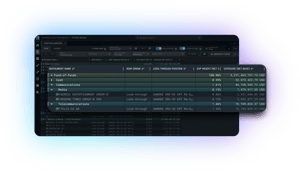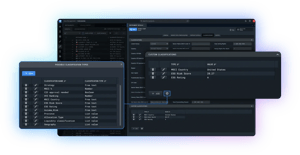
Pension Fund Software: Tools for Governance, Risk & Reporting
Introduction to this guide
The best pension fund software is both broad (covering many functional areas) and deep (covering all nuances a pension manager needs). This article goes into why and what those capabilities are.
Our founder and CEO, Kristoffer Fürst, walks you through pension fund management software in the video above.
Fund investments (including look-through), external managers & private investments
We recommend having one single pension software that can handle all workflows for all asset classes and investment types. The primary reason is that almost any investing activity affects cash. And you only have one pool of cash to manage, not one per asset class or investment type.
When you apply look-through on constituent/holding level, it’s beneficial for the software to model the underlying investments natively – regardless of whether that’s equities, fixed income or derivatives.
Look-through of holdings is needed to help you understand your actual exposures and performance. Look-through can be possible at both the constituent and proxy levels (e.g., “20% industrials”). Read more about fund of funds software.
For Private Equity (PE) and Venture Capital (VC) investments, a system should support capital calls, IRR-calculations and visualise committed capital.

Some systems might claim to be cross-asset, but that term can be misleading. Technically, it’s enough to support 2 asset classes to claim it. Equity is a broad term, and private investments differ in handling (technically for a system) from public equities.
Pension administration software’s ability to measure & control ESG
Many pension fund managers:
- Have ESG (Environmental, Social, Governance) driven compliance rules (limits and restrictions)
- Report ESG data on their portfolios
- Perform analysis and comparisons based on ESG considerations

Look-through is again a prerequisite for fund investments. The challenge of PE/VC-funds or direct private investments is further complicated since they primarily invest in private companies that might not report ESG data. In such cases, the pension fund software must be able to ingest proxy-data based on firmographics. In other words, for each holding company of a PE/VC-firm, map out what public companies are similar to those companies and approximate the ESG data based on that comparison. See Limina’s ESG capabilities in action today (no strings attached).
Front-to-back pension fund software
The functional breadth of a system is one of the most challenging considerations. It’s not common for one solution to cover all the depth (such as look-through, cross-asset and ESG capabilities) and the breadth (from pension fund accounting software to rebalancing) you need. Limina is uniquely well-fit specifically for pension funds.
The illustration below shows the possible functional areas to the left (divided in front, middle, and back). Each of the columns illustrates a system landscape
- From an all-in-one to the left (one system that covers all functional needs)
- To a best-of-breed to the right (different specialised systems for each functional area)
The blue is where Limina can fit in each setup.

Some nuances for pension administration software, specifically, include:
Rebalancing is a critical function of any pension fund management system, including capabilities such as:
- Allocate between investment mandates and funds
- Track targets through the rebalancing
- Simulate and track cash (forward-looking), with settings for:
- Trade vs settle date
- Order states (e.g. including simulated rebalance)
- Preliminary cash
- Plan exposures in time, for example, towards a set “deal date” or managing exposure if you redeem from a fund with an extended redemption period
If you make direct investments, classic trade order management functionality is also required.
Performing analytics on the portfolio shall be easily conducted within the system. Examples include weight vs benchmark, ESG exposures, interest rate sensitivities, etc.
The best pension fund systems also allow you to extract data via an Excel plugin - should you wish to perform further analytics outside the system.
Real-time market data isn’t always required but should be an option if you need it in the future.
Cash ladder that shows cash at any future date so that you can plan liquidity. Such projections need to display both trade and settlement date cash. Another useful functionality of pension fund administration software is being able to trigger on/off simulated rebalancing.
For cash management functionality to be complete, projected cash events such as capital calls and uncalled capital must be tracked in the software solution.
Whether you hedge FX or just manage liquidity in multiple currencies, your system must track each cash account and FX trades (spots, forwards of swaps). This is both if you manage FX internally or if these trades are imported into the system.
Fees and other non-investment-related cash shall be represented. With user-configurable import functionality (see below), you can automate cash imports without code (when using systems like Limina).
Setting NAV on portfolios is often standard functionality as part of accounting software. Where systems are set apart is the operational workflows and automation that precede the NAV. For example:
- Instrument validation rules (“is all data set”)
- Reconciliation (at a minimum with custody)
- Stale price & missing price checks
- Prior day tolerance check
- Comparison/benchmark check
- … and more
The best pension fund accounting software enables exception-based workflows (explained below).
Pension managers have recurring processes and ad-hoc projects. The recurring process can (in part) be managed with exception-based workflows within a system (assuming the pension fund management software you choose supports exception-based workflows).
A system that keeps track of all the recurring processes (including the automated ones) and projects is called an Operations hub. There are standalone Operation hubs and Limina comes with an embedded.
Performance measurement software is complex, especially when investing in close-ended funds and fixed income. Benchmarks often need to be blended or sub-portfolio specific.
While some pension software providers might have a broad solution including performance, it’s not a box-checking exercise “Performance” usually isn’t enough for a pension fund. We encourage you to dig deep and maybe even ask the pension software provider to do a sample report over a short time period to ensure it’s enough for your requirements.
All data and workflows in one place: then what?
Having a broad platform with all capabilities in one place can lead to significant operational gains and cost savings. It reduces the amount of data that must be synchronised between systems.
A cloud-native system (Software-as-a-Service, SaaS) is today the gold standard. Any system must provide secure access, support single sign-on (SSO) and be securely online accessible (at least via the web). If this isn’t the case, you know immediately it’s an old software that will be inferior in most aspects.
Assuming the platform you’re evaluating is deep enough in all functional areas, there are three more areas to consider before deciding.
Component #1: Connectivity
Even with an all-in-one system, you still need to connect for trading, to custody and often with a few other service providers or systems. There are 3 types of connectivity:
- Managed connectivity. Best for trading and market data, which is highly standardised.
- API or database access. Only a good choice when nothing else is possible.
- User-configurable import/export engine. Best choice for most connections except trading and market data. This type of connectivity is rare because vendors make money on the other two types. Limina is one of the few pension software providers with this capability, and you can watch a video of how it works here.
Component #2: Exception-based workflows (automation)
Exception-based workflow processes are an alternative to manual processes. Examples of tasks that the system will perform:
- “Check that…” tasks.
- Any task that resides on a calendar
- Data import/export tasks
- Data controls (e.g. price checks, instruments parameter validations, etc)
If issues are found, the pension fund management software will notify users. Some systems, like investment data management software, have this functionality. However, it makes less sense as a separate system because it adds a data complexity layer by being in a separate system.
We’ve observed that up to 10x more controls, checks and tasks are performed by managers with exception-based workflows enabled, without larger teams.
Component #3: Reporting enabled by the pension software
Reporting requirements are now much easier to meet since:
- All data is in one place
- All data is quality-controlled
- The system supports any state/view of the data
As a cherry on top, pension fund management systems like Limina have native Excel-plugins.
Explore a Better Pension Fund Software
Explore how Limina can help you enable exception-based workflows.







